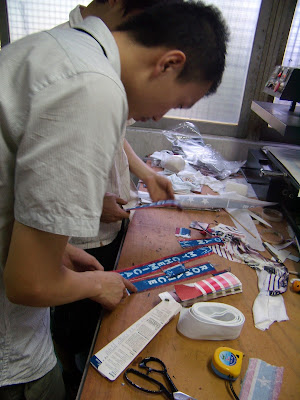 |
| Visit When Possible: check Pantone #'s, films, application |
The Factory’s Equipment: Much of the time, the factory’s computer equipment is dated, running off dated software and dated FAKE software.
Lack of Knowledge on the Files and Software: The folks working in the factories are not well versed in the fundamentals of the programs. They are not experts in Adobe, Corel, CAD. Normally the factories that are producing your items, do not have designers on staff. If they do any design work (and this is seldom the case), it is not done in house.
Films and templates are done at the filming/print factory. The filming/print factory is better versed on using these programs, but not by much.
If your contact at the factory you are dealing with didn’t properly communicate the info down the line, it will not make a difference if the filming facility is more capable.
…And most likely the filming company is also using fake and dated software.
Poor Factory Communication and “Face”: Since they are not skilled in the software and not great at managing electronic files, they will have issues in opening your files.
They will not tell you they have issues in opening your files. From the Chinese perspective, to mention, “I cannot open your files, please help”, would be embarrassing. They are also concerned about “troubling” you and do not want to bring this problem to your attention. In their thoughtfulness, they do not consider the “trouble” you will have in receiving 30,000pcs of wrong merchandise.
 |
| Low-cost factories usually use dated equipment & fake software. These factors but low design capabilities call for greater need for control. |
You also, obviously, give the factory artwork files for proper manipulation and application. The artwork may show the colors, all blueprint details, is exact and ready-for-use.
The factory, if they cannot open it, will not tell you. Instead, they will use the jpeg or pdf mockup, that isn’t proportionally exact and they will attempt to make their own artwork. They will actually put more work and effort on to themselves instead of discussing with you the best ways to obtain and open ready-to-use artwork.
In making their own artwork, the factory is resetting everything and this leads to untold errors, especially when there are things that are English or non-Chinese language specific. This is why many finished prints show different fonts, improper spacing, weird proportionality and are just flat-out wrong.
Shows Factory’s Lack of Understanding in Branding: The root cause is that to the factory, the branded area is still not an important part of the job. Branding is still in developmental stages within the country. So the factory is not so clear on why a logo would need to be exact.
In their mind, what is being produced is being sold off a store shelf and as long as it works, that’s the most important thing…who cares so much about the logo font, right?
(If you have the pleasure of coming to China and see what’s sold on the store shelves to the general public, you’ll see what I mean).
 |
| Just like in this menu: OK to print something "weird" if not fully understood...spareribs, anyone? |
Have the factory confirm to you they can indeed open the sent files. This may not necessarily mean they can open the file you sent, but in dealing with suppliers, asking them the same question, many different ways, can help get to the bottom of things.
Stick with mainly Adobe Illustrator. Adobe is the preferred software, over EPS, over PSD. When in doubt, use Adobe Illustrator.
Remember, especially if something is language specific, this requires even a closer eye, because chances are, your logo has been re-set. Be sure the factory provides you with preproduction samples. And without a doubt, be sure you’ve seen clear images of production and at best production samples before you confirm shipment and make the balance payment.
Abroad and dealing in branded merchandise? Share your successes or nightmare stories. What methods of control do you use? Any comments are appreciated...
Click on the title below for similar rants
I just discovered this piece and find it fascinating. As a digital retouch/illustration company in the U.S., we will keep this in mind if we get requests to forward files to China.
ReplyDeleteIt's amazing how relevant China is becoming to folks' daily lives around the Globe. Yes, if you or your team forward files and especially if the recipient company speaks English, take the time to have a phone/skype chat with both parties looking over the artwork and going over the details and interpretation. In fact, as you and your team probably already do, seems to be a good idea to discuss those details regardless of country / culture.
ReplyDeleteGood to see you here Mary, thanks for stopping by.
Great insight. Communication, communication, communication is the key. Understanding the cultural differences in dealing with problems is also important to resolving issues as well.
ReplyDeleteBrenda you are so right. Being able to know your partner, whether supplier or buyer and knowing their possible reactions...instead of assuming how you wished or hoped they would react. Not everyone is blessed with the same insight, abilities or sense. It's a matter of if you want to slow down, get it right and be helpful versus just pointing fingers and complaining.
ReplyDeleteWhat communication concepts do you employ in managing your overseas production?